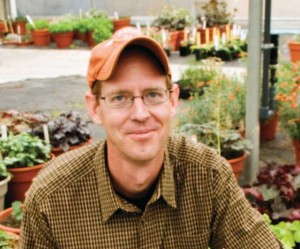Plant Breeder Hans Hansen: The Future’s Plants Will Be Smaller Versions Of Older Cultivars

Hans Hansen
Director of New Plant Development
Walters Gardens Inc.
Hans Hansen is the director of new plant development, heading up the hybridizing department for Walters Gardens Inc. in Zeeland, Mich.
A graduate of the University of Minnesota, Hansen has been hybridizing plants since he was in high school. At Walter’s Gardens, he manages perennial crops including hemerocallis, hostas, monardas, digitalis, baptisias, leucanthemums and ferns, among others.
What direction do you feel breeding is headed?
We are living in an absolutely incredible time to be a plant breeder. Recent advancements in science and technology are opening an entirely new direction and present fascinating new opportunities for hybridizers. These include new species recently being discovered, mutagenic plant breeding, new classifications of plants based on scientific studies and new tools not available previously. The internet has turned the world into a very small place.
What crops do you feel will be relevant and important over the next 30 years?
With the general gardening public having smaller gardens and less free time, popular plants tend to be types with a shorter juvenility period, easy of propagation and production and a long time of enjoyment and ease of culture for the end gardener. Many modern plants are a smaller, more manageable version of older cultivars. Plant shipping in flower has been a driving force in this trend, as well as smaller gardens. Plants with very sturdy stems, better basal branching, and longer flowering and foliage appeal adds to this.
Will the fervor for all new varieties continue in the industry or will breeders begin to focus on filling consumers’ needs?
Sales drive the direction of hybridizing. There are always individuals interested in obscure plants but to be successful, plants need to be saleable and accepted by the gardening public, not only plant collectors and botanical institutions.
How will breeders address needs to reduce chemicals by increasing crop resistance to pests and diseases?
Breeders and nurseries are selecting and breeding for increased disease resistance and better plant performance. Plants such as monarda are being developed for better, more attractive foliage that lasts longer in the season and has better mildew resistance.
How long have you been a breeder or studying to be a breeder?
I have been hybridizing since I was in high school, (1984) primarily Asiatic and Martagon Lilies. I have been working with Hostas since 1993. Other crops and genera I picked up later but I have always had a keen interest in perennials, even before kindergarten. That is how I am wired.
I have been employed as a professional plant breeder by WGI since June 4th, 2009, breeding such items as the Baptisia Decadence series, which has been picked up by Proven Winners.
What other crop areas are you interested in?
On a personal level, I rarely run across a plant I don’t like. On a professional level, the plant must generate enough revenue to be commercially successful, Sales dictate the direction of plant breeding for a profitable nursery.
What is one outlandish prediction you have for floriculture in the next 30 years?
I am looking forward to an increase in intergeneric hybrids, a recent example is the X Digiplexis carried by Cultivaris (T & M genetics), a hybrid between a familiar foxglove and a relatively obscure shrub from the Canary Islands that rose to popularity very quickly is an interesting example of the demand and curiosity of plant people for a synthetically produced man-made hybrid.










